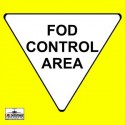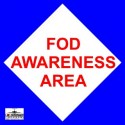Foreign object debris (FOD) is a major threat in manufacturing and aviation environments. Not only does it pose the risk of causing costly damage to equipment, machinery and vehicles, but it also has the potential to create dangerously unsafe conditions, particularly in active flight lines. However, most FOD is preventable with the right processes and the right equipment. Professionals use three primary FOD sweeper systems to control foreign object debris in larger FOD critical areas: tow-behinds, vacuum trucks and walk-behinds. Each of these systems has its own advantages and proper usage guidelines. To minimize the risk of foreign object damage in your aviation or manufacturing environment, it’s essential that you understand the relative merits of each major type of FOD sweeper.
The Tow-Behind FOD Sweeper
Tow-behind sweepers come in a variety of configurations and are valued for their (comparatively) lower operating costs and simplicity of operation. Unlike the other sweepers that typically have motorized components or complicated machinery incorporated into their design, tow behind sweepers are generally powered by external vehicles and are therefore easier to maintain and simpler to operate.
While there are many different models available, tow-behind FOD sweepers can generally be classified into industrial-grade or military-grade, and classified as either a spinning brush based system or as a friction mat system.
The major difference between an industry and a military tow-behind FOD sweeper is that military models tend to have faster travel speeds, sturdier construction and (where applicable) boosted magnetic capacities.
The differences between spinning brush systems and friction mats is that spinning brush systems use traction drive mechanisms to translate the forward motion of the sweeper into power to spin their brushes (with their spinning brushes collecting the FOD into containment hoppers), while friction mats are dragged along the surface to be cleaned and use kinetic energy to collect small FOD into collection pouches. Both varieties work well but spinning brush systems generally provide a longer service life, while friction mats are highly portable.
Here are some features to look for in tow-behind brush based FOD sweepers:
- Large magnets which quickly and effectively remove metal debris from open areas
- Storage trays for collected debris, which can be emptied simply by flipping the magnets over
- Varied sweeping widths, typically ranging between 4 feet and 8 feet
A tow-behind FOD sweeper is an ideal solution for managing and containing FOD when a blend of agility, efficacy, and cost effectiveness are needed.
Vacuum Trucks
These sweepers use powerful truck-mounted vacuums to remove FOD from large open areas. While FOD vacuum trucks can remove a comprehensive set of materials in a range of sizes, they are best for sweeping large areas where maneuverability is not a primary concern. Since FOD vacuum trucks are relatively costly to purchase and expensive to maintain, they are most common in commercial environments with higher operating budgets and larger volumes of FOD to contain.
Vacuum trucks are very comfortable to drive (providing a fully climate controlled working environment for the operator), and in wide-open outdoor environments where continuous FOD sweeping (8 + hours a day) is the norm, there is perhaps no better solution than a vacuum truck.
The Walk-Behind FOD Sweeper
These FOD sweepers are generally the lowest cost option. They fall into two principal categories, powered and non-powered. Non-powered walk-behind sweepers are usually designed with side broom assemblies mounted atop solid steel hoppers. These walk-behind FOD sweepers are very quiet to operate, require little in the way of maintenance, and provide a far more effective alternative to manual sweeping. These sweepers are best used in contained areas and indoor environments, as their smaller sizes limit their ability to cover large areas.
Powered walk-behind sweepers generally have small engines that power smaller vacuums or sweeping brushes. These sweepers tend to be similar in size to snow-blowers and are often used to supplement larger sweeper systems in ramp areas or other environments where high maneuverability is required.
Conclusion
Regardless of what combination of sweepers are employed in any specific environment, they are only going to be effective when used properly and as part of a comprehensive FOD prevention strategy, which includes thorough training of personnel, regular inspections of equipment and locations, comprehensive maintenance, and internal coordination among all levels of staff.
To learn more and connect with further resources, visit FOD News or FOD Control.



